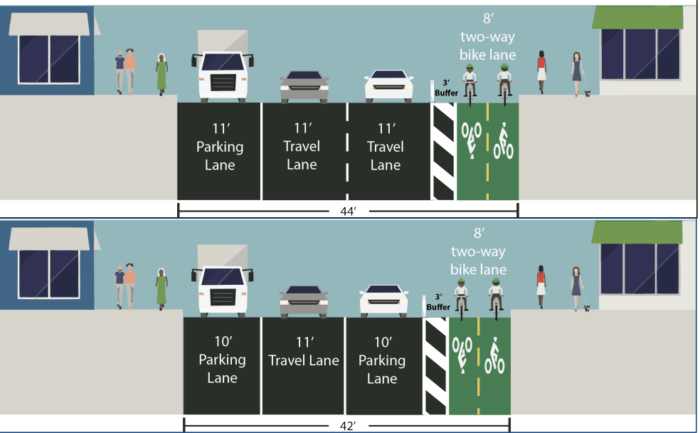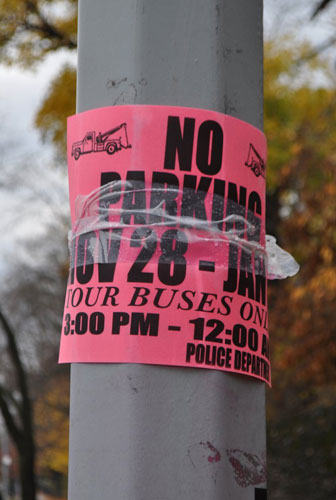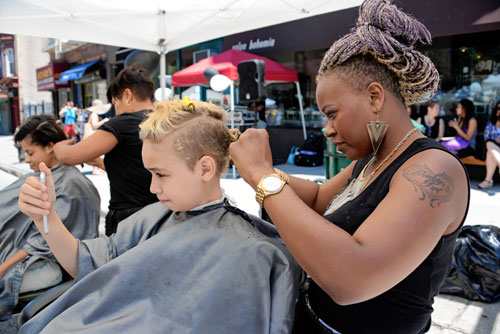City transportation honchos scrapped their plans to build protected bike lanes on both Seventh and Eighth Avenues in Sunset Park, opting instead to build a single two-way lane on Seventh.
“Through substantial engagement with local businesses and stakeholders, we are modifying our plans for these corridors to better address community needs — most importantly making the streets safer for everyone,” Seth Stein, a spokesperson for the city Department of Transportation, said in a statement sent to Brooklyn Paper.
While both avenues will still be converted to become one-way between 39th and 65th streets, the city DOT’s updated plan nixed the idea of having a single bike lane in both directions, and on both avenues.
The new plan will also keep parking on Eighth Avenue, while still extending the sidewalk near intersections.
DOT’s change of heart comes after some members of Sunset Park’s Asian community slammed the original plan as potentially destroying commerce in their ethnic enclave, as it would remove much-needed parking.
After several community board meetings, a lawsuit, and a protest outside of Transportation Commissioner Hank Gutman’s home, the community’s concerns were finally heard and the city agency offered a compromise— an altered plan that provides more space for cars, while still allowing for curb extensions at crosswalks and a protected bike lane to provide more safety to the pedestrians and cyclists in the area, which has typically lacked traffic-calming infrastructure.
The travel lanes on both thoroughfares will be reduced to one with Eighth Avenue traveling north and Seventh Avenue in the opposite direction, but they will both continue to feature two parking lanes from 39th to 60th streets in the modified proposal.
“The community is happy that finally DOT is really opening up and hearing our concerns,” Paul Mak, head of the Brooklyn Chinese American Association, told Brooklyn Paper.
Still, despite the major concession from DOT, Mak is still pushing for more changes to the street-design overhaul.
“There are still one or two issues on Eighth and Seventh avenues that we will be contacting the commissioner again and hope to resolve,” he said.

A major sticking point for Mak is he fears that outfitting the avenues with only one travel lane could create more congestion and create a standstill when double-parking inevitably occurs.
“The community is really concerned about the bottlenecking that will be created as a part of their proposal,” Mak said. “By only having one travel lane, whenever there is double parking, whenever someone puts their car in the bus stop… then it will really hold up the whole avenue with all the traffic.”
Mak said they plan to again reach out to the transportation commissioner recommending that his department construct two travel lanes on each avenue — but thanked the city agency for taking a step in the right direction by listening to their concerns.
“I really need to thank the DOT for really listening to the community,” Mak said, “and for making some major changes to their proposal, especially taking out the expansion of the sidewalk as well as the protected bike lane.”
But on the flip side, a co-founder of a southern Brooklyn bicyclist group is disappointed with the changes on Eighth Avenue as he was hoping the plan would calm the congested corridor and asks that the city agency not make any further changes to the now lacking plan.
“The plan they’ve come up with for Eighth Avenue largely is forsaken the benefit for anyone who is traveling on foot or by bike,” Brian Hedden, co-founder of Bike South Brooklyn, told Brooklyn Paper. “I wouldn’t say there is zero improvement on Eighth Avenue over what currently exists, but it is far inferior to what they originally proposed.
Although, Hedden said the city Department of Transportation turned around a better plan for Seventh Avenue with the adjustments.
“As far as the new proposal for Seventh Avenue, I would actually say it was better than what they came up with before,” he said. “My personal feeling is that DOT should be doing more two-way bike paths and one-way car traffic streets, I think it will be of some benefit mostly to the businesses on Seventh Avenue and to anyone who is going point-to-point on Seventh Avenue.”
He batted away the common “misconception” that installing a bike lane in place of some parking spots destroys small businesses, but instead argued that commercial areas that have seen the construction of bike lanes have reported boosts in business.
“it’s also a little concerning to me they used the language that implies bike infrastructure negatively impacts businesses when there have all sorts of information… that essentially disproves that notion,” he told Brooklyn Paper. “There are bike paths all over the city — a number of them go past commercial areas, those commercial areas are thriving.”
For Seventh Avenue, the plan includes an 8-foot two-way bike lane, with a 3-foot buffer, between 39th and 65th streets on the eastern side of the road.
From 39th to 60th streets, the bike lane is situated next to a 10-foot parking lane followed by an 11-foot travel lane and another 10-foot parking lane on the westerly side of the street. At 60th Street, an additional 11-foot travel lane will be introduced alongside the protected bike lane and the westerly parking lane will grow 1 foot to 11 feet.
Hedden added that the proposed Seventh Avenue bike lane will provide a long-awaited connection between Sunset Park and Bay Ridge as it will meet with the protected bike lane starting at 67th Street that runs south on Seventh Avenue.
“In combination with the two-way bike path that already exists south of 67th Street,” he said. “It’s going to create a really good bike connection between Bay Ridge and Sunset Park where one doesn’t really exist right now, not even the fourth Avenue lane connects those neighborhoods the way the proposed Seventh Avenue bike lane would.”
According to a schematic of the city transportation department’s proposal, there will also be some curb extensions and loading zones on Seventh Avenue as well.
Eighth Avenue will be outfitted with a 14-foot curb extension at intersections between 39th and 60th streets protected by an 8-foot buffer zone, immediately preceded by an 11-foot parking area protected by an 11-foot buffer, and a left-turn bay on the western side of the street.
There is an 11-foot travel lane and an 11-foot parking lane on the eastern side of the street. Between 60th and 65th streets, there will be an additional 11-foot travel line, hugged by two 11-foot parking lanes.
Widened pedestrian spaces and loading spaces are expected to be implemented at six Eighth Avenue intersections— which statistically account for a high percentage of injuries on the roadway and show a high risk of injury to cyclists— before the end of the year, according to the transportation agency’s spokesperson, but the rest of the plan will be delayed until the spring.
“We will focus on targeted improvements at the most critical intersections of this corridor for as long as weather allows this year; the remainder of the plan will be implemented next spring,” Stein said.























